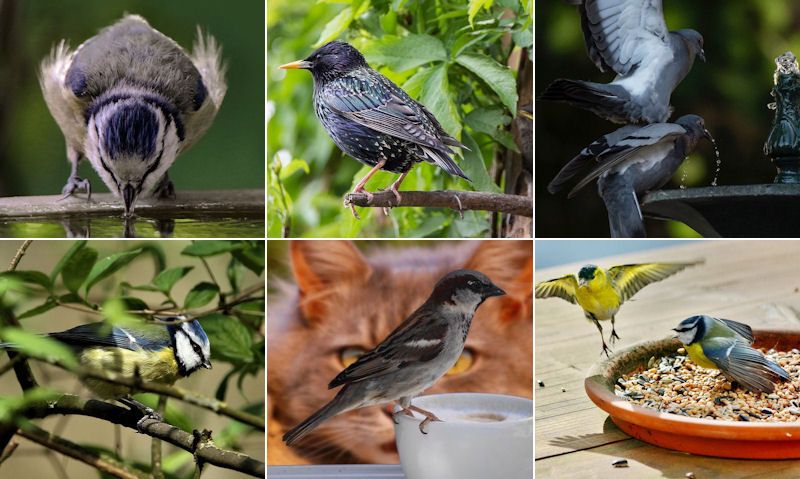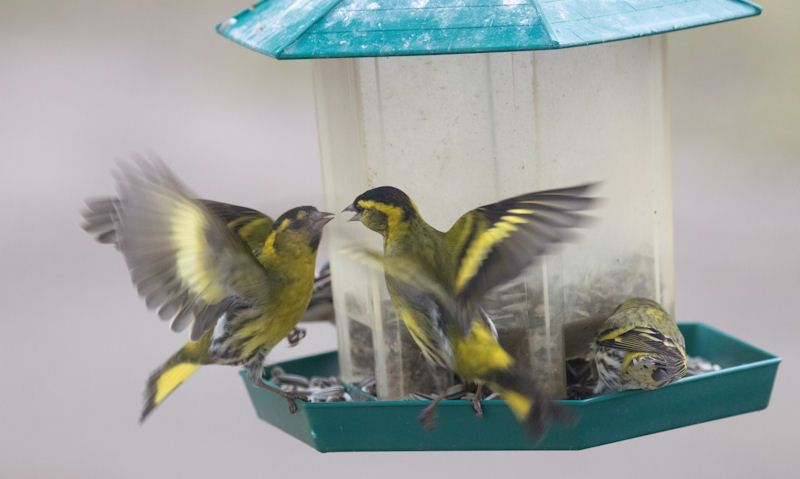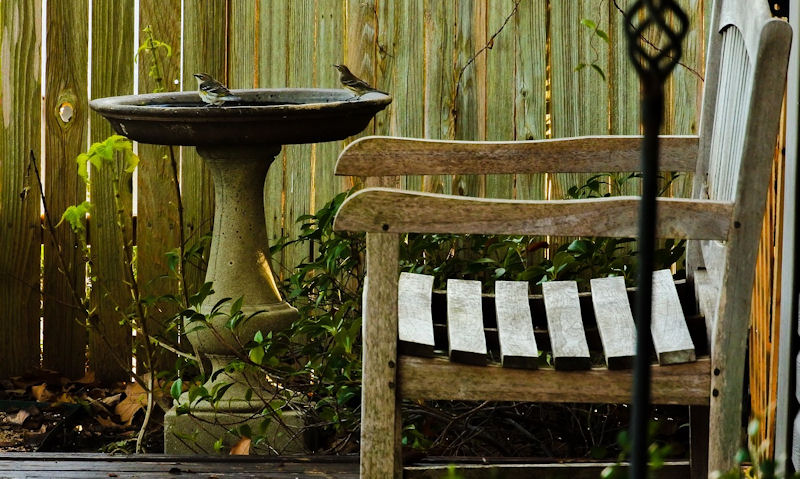Attract birds to garden (UK guide)
Wild birds will visit your garden if only by the presence of food, so you will need to setup a bird feeder with a variety of common bird food, hanging from various feeders.
When attracting birds to a garden you'll need to consider; coverage to hide, food sources, water supply and nesting options, with emphasis on food. To make this happen gardens should be kept clear of predators like cats, including nuisance squirrels and pigeons.
Likelihood of common garden birds visiting your yard is high, but you can go one better by making sure they keep coming back to feed.
Gardens with singing, noisy birds are simply a delight, if not a spectacular sight to see out of your window, and you're sure missing out if you have not had the pleasure.
You can change that by feeding birds on a regularly basis from a bird table or hanging bird feeding station, along with a good source of water.
If reading this article is based on absolutely no birds are visiting your garden, then following as many suggestions as possible may help attract birds to the garden, but be warned, it takes time, therefore patience from you.
If you're a big city dweller, council estate or country folk, it shouldn't really matter, its possible to attract birds to your garden under any circumstances.
That does not apply to noisy areas, pest control and cat problems, and generally kids playing in the garden all year round. All this activity around the bird feeding station would keep them away.
Before any of this can happen, let's discuss what keeps birds away in the first place.
First, let's deter predators
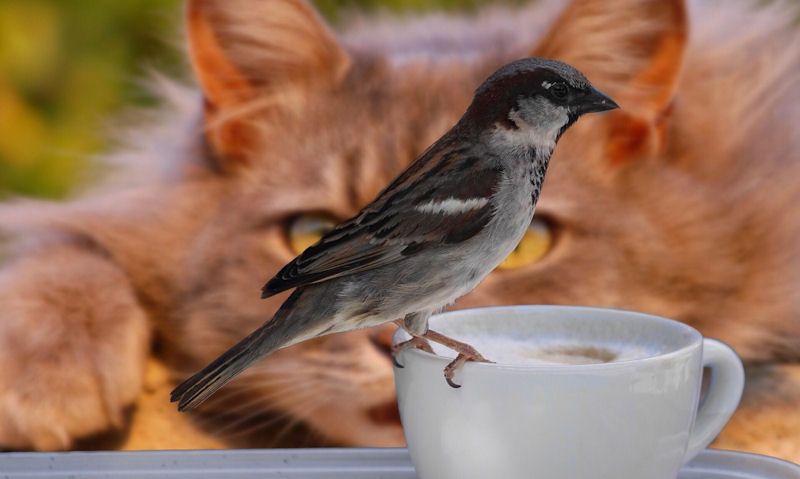
If you're going to attract birds to your garden you'll first need to keep unwanted visitors away... of course we're talking about anything from cats to pigeons.
Know that with any of these types of animals in your garden or even nearby, wild birds will simply stay away.
There're options to help keep them away all together; but know if you have a major issues with any of the following predators, there's not much you can do.
Realistically your neighbours cats are always going to come and go over the fence, so its just a matter of locating the bird food higher up.
Remember, to keep all predators away you only need to stop leaving out food for birds as its this they are usually drawn to.
Likewise, food brings wild birds which then encourage predators to stop by; leave out food for a short while to stop birds visiting, and see how you go from there.
Cats
Most peoples own experience stems from new neighbours cats. It always starts out being free from cats, before a new one slowly makes there way into the garden.
Usually its so they can poop all over the garden, but its this visitation that will keep birds away, simply be the presence of cats.
In the case of birds visiting your garden, we're sure you're limited to only the front or back garden, which happens to be the quietist, greenest side.
However, whichever side is full of green, luscious hedges and foliage, these are always the perfect feeding grounds for wild birds, so it can be restrictive.
And well you just may get a cat problem on the front and back, illustrated from cat poo problems, this alone will discourage birds visiting
The presence of cats would deter birds from visiting, let alone ever coming back, or worst still... being a victim to a lucky puss.
When a cat visits your garden there's every chance its the same one or two, so make it unwelcoming as often as you can.
Simply scare cats away by shooing or running at them a few feet until they clear off.
Foxes
If you get frequent visitation to your garden by a vixen and her pups, the problem could probably be eradicated by a simple fix to your garden parameter.
Hedgerows where foxes might enter are the hardest area to cover up, as small or large open passages create a natural way to access your garden.
You could stuff up these passages with use of freshly cut twigs and sticks you'll accumulated from cutting the hedge itself.
And well this is likely to last for a short period - if that - its to late to erect a wired fencing into the hedge, with the only option to put one up on the inner rim.
Access to your garden by foxes will likely come from the hedge, so do all you can to help deter them from entering.
However, if you get visits from lone foxes on the hunt they are more likely to be more adventurous without pups in tow.
So they are likely to jump up on a fence that's as high as 6 feet tall, so you'll need to make this fence higher if that is an issues for you.
If you're located near woodlands then this fox problem only refers to you, well houses in built up areas or deeper in the suburbs usually just have to deal with cats.
Deterring unwanted guests
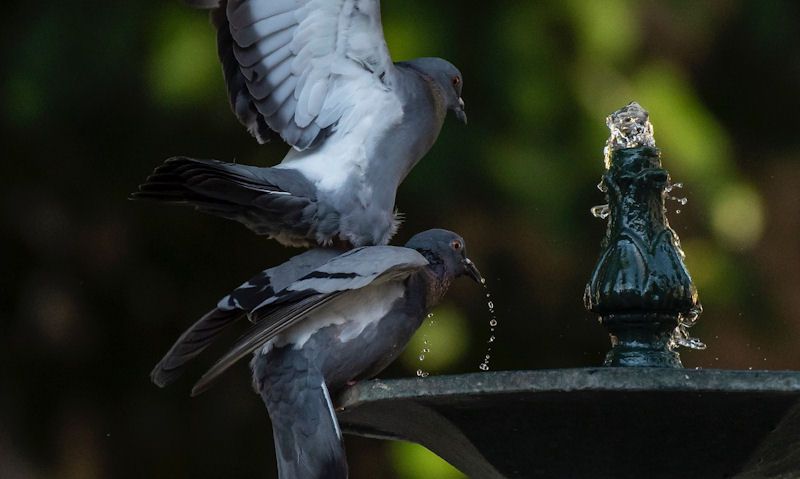
The present of nuisance wildlife can deter birds; wild birds are happy to fight for food among there own, regardless of bird pieces
However, they will never eat with squirrels or pigeons present, or even rats for that matter as they will catch and eat a bird given the chance.
Its similar to the presence of people or pets in the garden, where there's movement and potential danger, birds will stay away.
For most of us, keeping pigeons, squirrels and even rats away in problem areas is never a possibility, but there're options to help reduce daily visits.
This will in turn give you breathing space to feed the wild birds in the garden.
Though it is possible to stop any of these nuisance creatures from ever eating the bird food by not putting it out in the first place, in turn, this will also protect birds from danger.
Only setup up a bird feeding station on a pole as this post would make it hard for squirrels and rats to climb, so place it as high as it could possibly go.
That also goes for the hanging bird feeders, hang them up as high as they would go so its always out of reach of squirrels or rats.
You could fortify the feeding station with use of spikes or even oiling the pole to make it anti-climb proof. Again, that is a short lived solution as you'll need to re-oil regularly as it dries out.
Squirrels
Well it might be nice for squirrels to stop by for some people, those of us who prefer the presence of wild birds would have to go without squirrels in our garden.
If you're in a built up suburb then you should be fine; though its made incredibly difficult to keep squirrels away if you're near there natural habitant - which is near the woods.
When squirrels visit your garden they're only after one thing... food.
You can stop feeding wild birds for a short while as it should keep squirrels from ever visiting, or what we would recommend is setup a squirrel feeding box.
This wooden box of nuts can be located up a tree out of the way, but not so well hidden the squirrels can't find it - or where you can't refill it for that matter.
Realistically this method is only short lived as the nuts run dry, so in this short period you can use it to feed the wild birds back in your garden.
You could make the bird feeders squirrel proof with the use of a blocking cage that surrounds the seed, peanut or fat ball feeders.
If squirrels are never given a chance to eat the bird food, there's no reason for them to drop by, so never allow squirrels to feed in your garden ever.
If you're using a bird table make it a squirrel proof one, likewise; if you're feeding birds on the ground feeder, use an appropriate blocking cage over it.
Well squirrels will for certain try to eat the bird food, they will also attempt to take away the eggs inside the bird box, so make sure its high up and far out of reach.
Pigeons
Well most of us receive visitation from Woodpigeons on a regular basis, know that well they are harmless to small garden birds, smaller birds won't eat with pigeons.
Large, awkward as they are, pigeons have big wings that flap all over, making it hard for small birds to eat at the feeders, so they prefer to stay back until the pigeon has gone.
To keep pigeons off the bird feeder you can use a series of useful techniques.
That includes the use of harmless spikes that prevents the pigeons from ever landing on the pole, bracket or top of the bird table.
Pigeons usually stop by from where they nest in nearby trees, so its not a case of removing the food source as they're present all year round.
Unfortunately, pigeon will keep coming back regardless of food availability, that also goes for the bird bath or any source of water built up in your garden.
Food Woodpigeons eat out in the wild includes crops, buds, seeds, nuts and berries, so any berry bush in your garden may be swallowed up by them.
Rats
Presence of rodents in your garden would keep wild birds away; rats scrounge through rubbish on the ground or in bags.
They will also be interested in the bird feeders containing peanuts, seeds and fat balls especially. If you leave out scraps for birds such as bread, its time to put an end to it.
Likelihood of rats visiting your garden could happen regardless of how clean you keep yours, so for that reason all attempts may be futile.
Its your neighbours who are to blame for rats with hoarders or people or just keep there garden in a poor state; never taking out bin bags or cleaning up rubbish off the ground.
Unfortunately, the visitation of rats will spill over to your garden as the rats seek out more food sources.
If they were kept away in the first place then these issues would not of arisen, but now the rodents would make an habit of dropping by.
And as most of us who keep bird food out in the garden all year round, those same rats can sniff it out, so will come by to investigate.
We never want rats visiting our garden as they carry diseases, likewise we never want them to come near or let alone touch the bird feeders or the bird bath.
Its impossible to keep rats out of your garden other then discussing the issue about your neighbours unkempt garden with your local council, which would hopefully result in forcing them to take action in a certain time.
Hopefully this will see a reduction in rats before they hopefully disappear all together.
Coverage
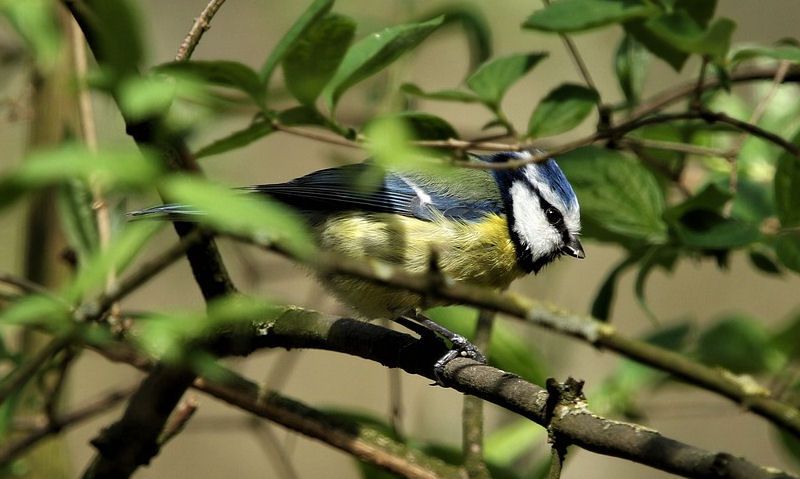
If you're lucky enough to live in a house with a lush garden with lots of green grass, hedges and bushes, birds will soon come with a supply of food left out.
Saying that, without food left out they will still drop by to feed on the ground or eat the berries on the shrubs.
If the home you live in lacks basic greenery; hedges, bushes, trees and thick foliage, chances of wild birds visiting decreases, but you can still get lots of visitors regardless.
Wild birds need to quickly vanish when ever they are disturbed well feeding, and a close by hedge or thick foliage would make the ideal nearby spot to hide away.
They will need this coverage to escape predators such as cats, but its mostly people they fly away from.
If your garden lacks all this green, they may stay away, but not entirely providing you have a good number of bird feeders setup.
So if your garden lacks all this natural coverage, there's no bad time to improve on things by planting trees, shrubs and a hedgerow now, on a single spot or running along side a wall or fence would be better.
If you want to quickly grow foliage, the solution would be to site a bunch of flower pots, planters and hanging baskets in close approximate, therefore when they grow out in spring and summer, the birds have cover.
You could play the long game by planting short stem plants or trees. And if possible grow an hedge along the wall or metal fence.
Hedgerow
The idea with any garden surrounded in hedges would be the best setting for a bird to feast, with coverage in all directions.
Nice big garden with hedges a plenty are the ideal grounds for birds, made better with lots of foliage and the occasional bush centred in and around the garden.
If you don't have an hedgerow now get planting; it can take years before its in full bloom but birds will make most of it has it grows over time.
Avoid a fur tree to be pruned into a suitable bush as they can take ages, and as they're grown in a tight, compact way, it leaves little room for birds to dive into.
Trees
We're not all blessed with a small tree in our garden, and if we were it might not be a suitable one if it lacks coverage with leaves - though its a good spot to hang feeders.
By hanging a bird feeder on a tree as oppose to a feeding station out in the open, this will guarantee cover from all weathers well keeping it shaded from the sun.
If you do have a tree regardless of size, use that for hanging bird feeders to the branch, with no artificial bird tables or feeding stations needed.
Very often wild birds will scatter with only the slightest noise or movement, even more so as you pass windows inside the home, so a tree offers a great height advantage as they don't need to fly off but rather perch in the tree instead.
Berry shrubs
Not only will growing a berry bush in your garden provide natural cover, but berries grown on such shrubs just might attract birds to feed off them.
As the RSPB say, they're never the prettiest of bushes to have in the garden but they sure do make for enticing wild life.
While not always the prettiest of shrubs, berberis (also known as 'barberry') are hardy and tolerate all but dry soils, and provide valuable ground cover for birds, as well as berries - RSPB
Most berry eating wild birds will benefit well other birds that need a suitable nesting site with natural cover may like to setup a nest in a shrub if it was planted in the ideal spot.
All common British garden birds will nest in brambles; such as Robins, Wrens, Blackbirds and Finches, so the more shrub offerings the better.
Green green grass
Not a necessity but a garden with significant lawn cover will help towards bringing ground feeding birds to your garden.
And what we mean by that is with the cover of grass comes wild life such as worms and insects that birds eat, just the kind of thing they thrive on.
If your garden is made up of stone and decking with no intention of laying a lawn, then consider pots or large planters as ground feeding birds might eat from them.
With only a patio or decking - on the front or back garden - then think of hanging plant pots or planters as an alternative to the use of grass.
If you do not have grass coverage know that this is still the best way to attract birds.
Not only does it make it easier to position a bird feeding station, rather than relying on one with a base or stabilising legs, but you can impale deep into the soil.
Food
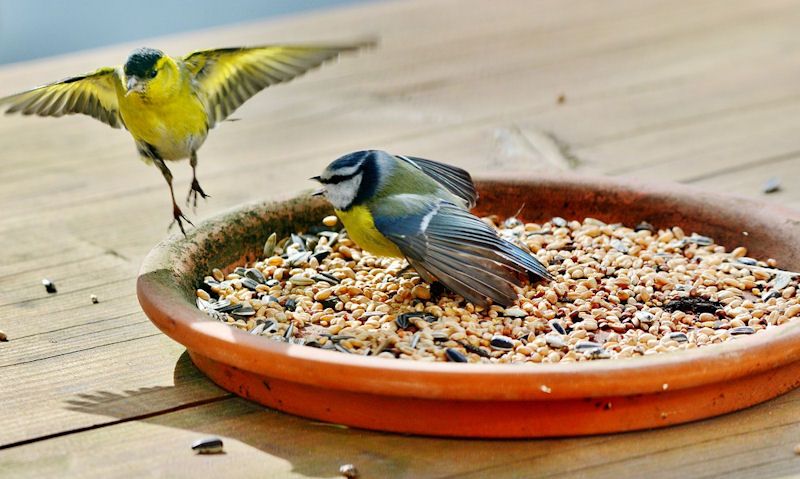
Only way to get wild birds to visit your garden is with a constant supply of bird food all year round, with additional natural food sources making up the shortfall.
This includes eating berries if available, plus eating insects and bugs off the ground.
To offer visiting birds a quick bite you'll probably need the use of bird feeders, with one that is likely to suite your needs, and those of the birds.
Likely bird food you will leave out is limited to peanuts, seeds or fat balls only, or all of the above with a number of purpose built feeders available to buy.
Well emphasis should be put on the summer or winter times to help build up fat content or protein, just forget about that for the moment and just focus on making sure you have common bird feeder out in the garden at all times, despite seasonality.
Bird food regardless of quality is not very expensive, but you should always go for the feed that is of the highest quality, therefore the all important nutrients are not lost, as they are with cheap, inferior brands.
To attract the widest bird species to the garden, be sure to throw food over the lawn for those birds that can't or refuse to use the feeders.
To feed birds in your garden, let's take a look at the most popular options...
The Big three: Peanuts, Seeds & Fat Balls
There are three major bird food types to focus on that are more likely to bring birds to feed in the garden than others, these include; peanuts, seeds and fat balls.
All of which are readily available for all year round and will withstand the harshest outdoor conditions, not before they are quickly snapped up that is.
Fat balls help build up fat content in the winter months which is essential for making it through the blanket of snow that stops birds from feeding.
Seeds are a mix of several types, but would usually contain some sunflower seed, with the occasional nygar seeds thrown in, of which they're high in fat and calories, perfect for all year round.
Peanuts offer the all important protein well being high in fat and calories, well the mix only extends to peanuts only, you might find similar, but cheaper nuts. Out of the shell and ready to eat, just use a suitable peanut bird feeder.
Fruit eating birds
Not a lot but a few wild birds can be attractive to eat in the garden with the presence of dried or fresh and juicy fruit left out for birds to either eat or sip on.
All fruits are suitable with a few being more successful than others.
Birds will eat Strawberries, they will also try apples but they absolutely love eating raisins which stem from grapes, which birds also eat.
Presenting fruits to garden birds has one major flaw, just how do you give it to them.
This is not an issue for apple varieties as there is an apple bird feeder you can buy, which might come in useful for impaling oranges.
Likewise, and well still small, an apple feeder might be used to impale grapes that bird eat plus the strawberries if no suitable surface or platform is available in the garden.
Scrap food
When in short supply of bird feed at a time your garden is buzzing with wild life, you could raid you pantry or kitchen cupboards for food birds will eat.
And well you must take care to NOT feed birds harmful foods, it is still possible to feed birds things like bread, but never in large quantities.
Well not healthy, bread still provides some nutrients. But be warned, most breads are just fillers with no substances whatsoever, so don't leave out to much if its just white bread.
Other scraps birds could eat can include cat or dog food.
Then there's food that needs to be cooked beforehand, including: boiled potato, pasta and rice with uncooked, unsalted bacon rinds.
Bird will also take to eating cheese, whether that be Cheddar or Brie, it really doesn't matter, feel free to try it all.
Sweet treats
Unconventional bird food extends all the way to peanut butter would you believe it, but with less sugar, no salt - but still enough to tempt them with the yummy sweet smell.
Not like what people would eat but peanut butter for birds is formulated to be healthier with more nutritional value.
Remarkably, where there's peanut butter you get corresponding peanut butter feeders for sale in the UK (its sounds like an American thing but its really popular here).
You're sure to attract birds to the garden with the sweet smelling, tasting peanut butter just as long as you keep it out of reach of pets and children.
Remember, peanut butter for birds is not safe for human consumption.
Attract birds to feeders
Obey the simple rules of setting up a bird feeder by not using one, but several feeders that are made to accommodate all types of feed, and in turn, the widest bird species.
Its not one size fits all, in fact seeds, peanuts and fat balls need a feeder that allows the birds to feed well preventing the food within from dropping to the ground.
More the merrier in regards to hanging bird feedings, with the option to hang several from a bird feeding station pole with brackets, or use inventive ways around the garden; such as hanging from a tree, bracket, flower pot, gazebo or shed.
If using hanging bird feeders for seed, peanuts or fat balls, know that placement of bird feeders should not put birds in danger.
So if setting up a feeder on a fence post where the neighbours cat frequents, this is not a good start, nor is the shed roof where the cat can reach down.
Let's take a look at your options and how they benefit all types of bird species.
Bird feeding station
Quite possibly the easiest and quickest way to get a multi-use bird feeder up and running in no time without the need of buying individual bird feeders.
With use of a bird feeding station on a pole, all is included with a seed, peanut/nut, fat ball feeder and a water bowl - which is mounted on, as oppose to hanging.
The use of a bird feeding station will focus the feeding area in the garden, rather then forcing birds to look all over.
And well a centrally located feeder on the lawn would look more attractive, make it so you can see the birds feed, coming and going well observing there behaviour.
Peanuts in mesh
Long or short, but never wide, peanut feeders are made with a wired mesh for the birds to feed on from all angles, so this feeder becomes the most popular.
Even more so with squirrels, if they're a problem make sure you get yourself a squirrel proof bird feeder with the peanuts at the centre, but out of reach of squirrels.
Basically made from a metal mesh wiring, this allows for birds to perch all around well grabbing and pulling nuts through the gaps.
As the feeder gets lower on say plastic tube feeders for seeds, its becomes more difficult to eat the remaining seeds, not so with a peanut feeder...
With mesh wiring connecting from the very top to the very bottom, every last nut is likely to be reached with non going to waste.
Seed in plastic tubes
All types of bird seeds will fit into pretty much all brands of seed bird feeders you can buy, though remember, the smaller the tube the less seeds are needed.
No need to go overboard filling up a seed feeder as they get used up later than peanuts and fat balls, so are a little less popular.
Long, clear thin tube full of seeds grabs the attention of small garden birds, as they stand on small perches with openings only allowing them to feed, keeping bigger birds at bay.
All types of bird seed feeders are available, but for the most part, sunflower and nyger seeds are compatible, with no reason to buy a specialty sunflower/nyger feeder.
Fat balls in cages
Everyone needs an hanging fat ball feeder as its one of the top food sources at the feeding station, and is more essential during the winter months.
That big tub of fat balls seems a lot at first, but you'll soon relies how popular fat balls are as they disappear quickly.
Prioritise the fat balls by making them one of the three major food sources on the bird feeding station.
If you don't have a specialty bird feeder for fat balls, use the fat ball variety that comes in 3 or 4 contained within a bright orange netting.
This netting will hang anywhere thanks to the mesh, with a suitable tree branch ideal. We have to say we don't encourage the use of this plastic netting.
Mealworms, alive or dried
Birds that eat insects will also eat dried mealworms, preferable you'd want to mimic there natural feeding instincts by spreading mealworms over the lawn.
They will now scorer the ground searching for dried or alive mealworms well eating all other types of insects on the lawn along the way.
There're two mealworm bird feeder options to buy; plastic tube or a covered tray.
Well the plastic hanging mealworm feeder is essentially a clear plastic tube, the dish located at the base helps catch the mealworms well providing a little plate to perch.
And if there's no room on the feeding station why not use a mealworm mesh tray with a plastic cover to keep the rain off.
Mesh tray or dish
Often hanging bird feeders can become quite tiresome for birds to feed on, so why not make it easy by laying out food on an open bird tray.
Made from metal in a mesh for moisture and water to pass through, bird trays are the most hygienic garden bird feeders available as the food is out in the open, therefore easy to clean.
When we talk about hanging mesh feeding trays, they're used to hang up on a wall bracket on simply placed on a surface.
Likewise, a bird dish or bowl are usually reserved for the bird feeding station, which is vital for offering water, not just food.
Bird table with platform
Rewarding as they're attractive, traditional wooden bird tables are used for the sole purpose of offering bird food in a safer environment, well keeping food covered.
This large open platform can be used for all types of food, well a dish of water can be inserted if its a table with enough room to spare.
In a way, wooden bird tables function similar to a metal bird feeding station, only the food you leave out on bird tables are not exposed to the elements.
With use of a specialty bird table for small birds only you can deter larger birds well making sure the small garden birds can feed in complete safety.
Made from wood, the post is usually joined to four legs that stabilises the table, with bird tables not really designed to be impeded into the ground.
Water
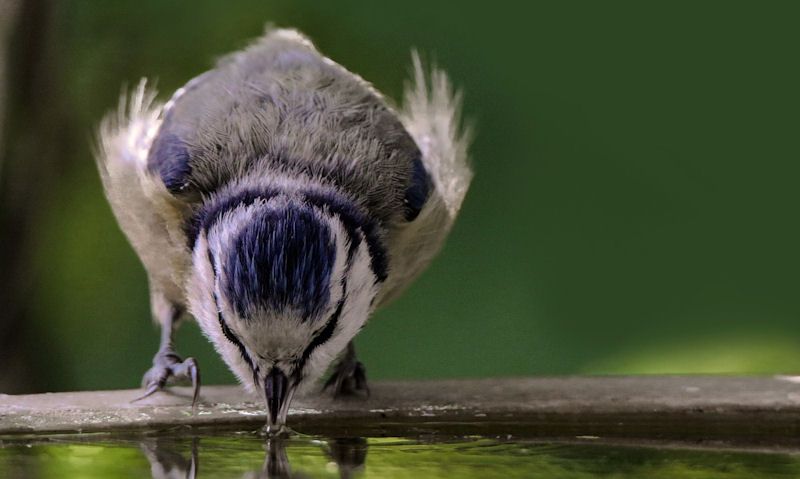
Leaving out water for wild birds to drink or bathe should be given as high priority as food, but most people don't see it that way, instead focusing on feeding them only.
If you have a constant supply of fresh water in your garden all year round you will increase the number of birds who will drop by, thus attracting even more birds to your garden.
You're not limited to use of setting up a bird bath, in fact no item needs to be bought especially as birds will drink out of anything if the water is shallow with a perching area.
And if the water is situated in a reasonable spot, they may take to bathing.
Remember, like bird feeders, drinking bowls and baths for birds need cleaning out, well filling it up with fresh water if the rain hasn't done it for you.
Pedestal bird bath
Pedestal bird baths are the 'go to' item for providing a source of water for birds, but be warned, they do have there downsides.
Well usually made in a light, flimsy plastic, they're almost certain to tip over which increases the chances with birds perched on the edge.
More times than not people would simply site the pedestal bird bath in the centre of the lawn or patio and forget about it.
But in fact it does needs securing by stabilising with pegs, with the bird bath sited in plantation or at least with it near by.
Don't isolate the bird bath as its need hedgerows, shrubs or plants just as you would site a feeding station if birds are ever to use it.
High quality bird baths other than the pedestal design is available, among them hanging bird baths or ones made from stone, which are recommended.
Upside down bin lid
As it happens you don't need to go out and buy yourself an expensive, fancy bird bath, all that is needed is an object often found in ones garden, simply a bin lid will do.
Problem with this solution of course is cats can now access your bin, well the garden looks untidy with a bin lid on the ground.
But if this option is not a problem to you then go for it; its an inexpensive way to experiment with location, well waiting to see if birds will actually drink, or even bathe in the water.
Seek out a big rounded stone or use a house brick and sit it around the rim of the lid, or drop it into the water securing it in place; it will now become a perch as the birds drink.
Bird water bowls
If the random item in your garden is not your thing - its not for everyone - then take a look at simple water bowls.
If you have a bird feeding station with all accessories included, then a mounted water bowl is likely to be included, so fill it up with water.
However, you can buy specialty hanging bird water bowls that can be hung up on a wall bracket, or replaced with the hanging flower basket.
Offering water to birds does not need to be complicated, it just as to be visible and seen by all passing birds if they're ever to drop by to take a drink.
Hanging water dispenser
Treat the source of water with the same importance and effort you put into feeding them from bird feeders, with a hanging water dispenser that imitates a feeders design.
It won't cost much extra with a hanging bird water dispenser which can hang with the food or on an isolated spot.
Its possible to hang it from a washing line to even hanging it off the bird table. Like we've mentioned previously, just site it where it can be clearly seen.
What you do is fill up the plastic water jug all the way, screw the lid back on which also acts as the drinking bowl, before tipping it upside down onto to a bracket.
We can now guarantee fresh water for a longer period as its unlikely to get contaminated like water that is left out in the open.
Nesting
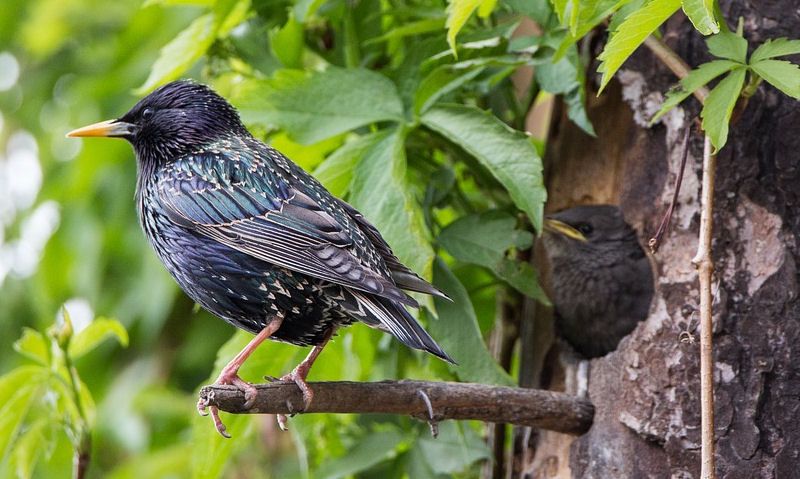
Solution to attracting birds to your garden in the UK may come from nesting birds, rather than relying on food supply so much.
Its vital you try all options available to you, so by setting up a bird nesting box we cover all suitable options.
Before investing in a bird box, you'll need to ascertain where to site a bird box in your garden; north/east facing will keep the sunlight away well avoiding strong westerly winds.
Much of the Tit family and Sparrows are going to be the most likely occupants, but if you've never seen one then the chances of a bird nesting in your box decreases dramatically.
Regardless, setup a bird box in a quiet area along with food and see what happens, though there're things you can do to improve your chances.
Multiple bird boxes
There may be a time when you realise the bird box has never had so much as a look in, therefore the location of the box will have to be positioned elsewhere.
Did you know you can site multiple bird boxes in your garden, and well they should not be setup close by, nor in sight of the bird feeders.
Though the question you should be asking, does your garden have the available space for more than one box. If so, then go ahead and site a box away from the original.
If one box isn't cutting it, or two or three, you'll need to reposition the boxes over the months until a bird is interested.
Setting up multiple bird boxes around the garden should reduce the time wasted positioning the one, well speeding up the chances of a bird nesting with a few.
What type of box
Well your garden may suit a decorated bird box that would match the colour and theme of its surroundings, make it a wooden bird box with a hole for small birds.
That way you're not limiting your options to the type of birds that nest in boxes.
And well a small 25mm or so entrance hole will attract all the Tits and Sparrows, a larger one at 28mm will keep your options open.
If its a Robin or Wren you want to nest - you must be aware they occupy your garden already - then make it an opened fronted bird box to attract them.
If going for a ceramic box, keep it in a shaded area for sure, as ceramic nests can become hot when exposed to the sun.
Play safe with a wooden box only, sited where it can be seen by birds but accessed by you for cleaning it out.
Keep it clean
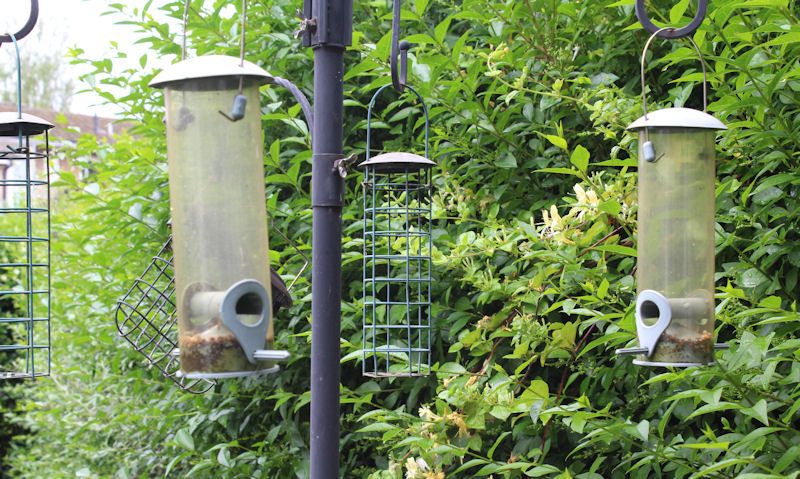
Poor hygiene around the bird table, bird bath and inside the hanging bird feeders is enough to actually discourage birds, therefore keeping them away all together.
If you're regularly feeding them, leaving out water to drink and bathe in, you need to clean out feeders and bird baths or dishes on a regular basis.
We recommend you clean out the birds feeders at least once a week with a disinfectant made for bird products especially.
If wild birds can sense moldy, unpleasant food kept in the feeders, they may not feed at all, and worse still, never return.
So to keep these little beggars coming back, provide them with fresh bird food served in clean bird feeders that are washed thoroughly at least once a week or so.
Its worth your while cleaning bird feeders, tables and hanging trays on brackets before the build up of grime, making it easier to clean than tackling the tough build up later.
This also puts an end to the growth of bacteria, stopping it in its tracks before it contaminates the food.
And remember bacteria on bird feeders of all types needs removing more than ever before as its already a widespread killer of birds.
Clean feeders before you refill is the best habit to get into...Its quite easy to refill the bird feeders when there empty without taking into consideration health issues.
You see quite often people will refill a bird feeder before its empty, therefore the rotten food remains.
To overcome this wait until the feeder is as empty as it will ever be, then remove it from the feeder before the birds are back.
Take this time to dismantle the feeder following the manufacturers instructions, and give it a good scrub with a brush, making sure all congealed, stuck bits of food are removed and washed away.
Success brings all birds
If you've developed your garden into a natural, outdoor avery that will attract all types of birds, expect to be rewarded with all British common birds stopping by.
And well that might only apply to common birds that are in your area in the country, we can say for certain most small garden birds will visit.
Reliable as the are easy to see, you're guaranteed to get regular visits by the entire Tit family, including: Blue, Coal, Great, Marsh and Willow Tit, less so with the Crested, Long-tailed and Bearded Tit.
Birds that usually stay out of the garden such as Blackbirds will drop by but not so much as the always reliable Sparrows, more so than the Tits.
Not just for Christmas or winter visitor is the Robin, often following the actions of the Tits with they eat and how they behave.
And if you're lucky enough, you might see the rather agile Wren with a number of Thrushes, a Dunnock or any bird likely to eat from a garden.
Conclusion
Comfortable environment, coverage, food, water and nesting possibility are all attractive to a passing bird, and if its suits them they will investigate, before more birds come by.
Subjects we've covered include an assortment of food fed to them in bird feeders, an area to drink water and bathe - including the possibility of setting up a nest box.
Does not apply to all gardens as location is vital to attract all types of birds, though you can always rely on Tits, Robins and Sparrows to say hello.
When attracting birds to your garden, make it as green, luscious as possible.
If your garden lacks bushes, hedgerows and trees now, its never to late as its possible to plant now to see growth - and in turn - birds using the early rising branches or leaves.
